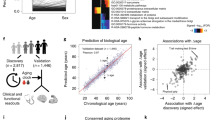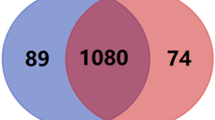Abstract
Objective
Human blood plasma is a complex that communicates with most parts of the body and reflects the changes in the state of an organism. Identifying age-related biomarkers can help predict and monitor age-related physiological decline and diseases and identify new treatments for diseases.
Methods and Participants
In this study, TMT-LC-MS/MS was utilized to screen differentially expressed plasma proteins in 118 healthy adults of different ages. Participants were divided into three groups: 21–30 years of age (Young), 41–50 years of age (Middle) and ≥60 years of age (Old).
Results
The number of differentially expressed proteins in the comparisons of Young vs Middle, Middle vs Old and Young vs Old were 82, 22 and 99, respectively. These proteins were involved in numerous physiological processes, such as “negative regulation of smooth muscle cell proliferation” and “blood coagulation”. Moreover, when Young was compared with Middle or Old, “complement and coagulation cascades” was the top enriched pathway by KEGG pathway enrichment analysis. Functional phenotyping of the proteome demonstrated that the plasma proteomic profiles of young adults were strikingly dissimilar to those of the middle-aged or older adults.
Conclusions
The results of this study mapped the variation in the expression of plasma proteins and provided information about possible biomarkers/treatments for different age-related functional disorders.







Similar content being viewed by others
References
Booth LN, Brunet A. The Aging Epigenome. Mol Cell. 2016 Jun 2;62(5):728–44.
Willcox BJ, Donlon TA, He Q, Chen R, Grove JS, Yano K, et al. FOXO3A genotype is strongly associated with human longevity. Proc Natl Acad Sci U S A. 2008 Sep 16;105(37):13987–92.
Sebastiani P, Gurinovich A, Bae H, Andersen S, Malovini A, Atzmon G, et al. Four Genome-Wide Association Studies Identify New Extreme Longevity Variants. J Gerontol A Biol Sci Med Sci. 2017 Oct 12;72(11):1453–64.
Revelas M, Thalamuthu A, Oldmeadow C, Evans TJ, Armstrong NJ, Kwok JB, et al. Review and meta-analysis of genetic polymorphisms associated with exceptional human longevity. Mech Ageing Dev. 2018 Oct;175:24–34.
Ye S, Ma L, Zhang R, Liu F, Jiang P, Xu J, et al. Plasma proteomic and autoantibody profiles reveal the proteomic characteristics involved in longevity families in Bama, China. Clin Proteomics. 2019;16:22.
Bjelosevic S, Pascovici D, Ping H, Karlaftis V, Zaw T, Song X, et al. Quantitative Age-specific Variability of Plasma Proteins in Healthy Neonates, Children and Adults. Mol Cell Proteomics. 2017 May;16(5):924–35.
Di Narzo AF, Telesco SE, Brodmerkel C, Argmann C, Peters LA, Li K, et al. High-Throughput Characterization of Blood Serum Proteomics of IBD Patients with Respect to Aging and Genetic Factors. PLoS Genet. 2017 Jan;13(1):e1006565.
Wang Q, Su X, Jiang X, Dong X, Fan Y, Zhang J, et al. iTRAQ technology-based identification of human peripheral serum proteins associated with depression. Neuroscience. 2016 Aug 25;330:291–325.
Ignjatovic V, Lai C, Summerhayes R, Mathesius U, Tawfilis S, Perugini MA, et al. Age-related differences in plasma proteins: how plasma proteins change from neonates to adults. PLoS One. 2011 Feb 18;6(2):e17213.
Tanaka T, Biancotto A, Moaddel R, Moore AZ, Gonzalez-Freire M, Aon MA, et al. Plasma proteomic signature of age in healthy humans. Aging Cell. 2018 Oct;17(5):e12799.
Lu J, Huang Y, Wang Y, Li Y, Zhang Y, Wu J, et al. Profiling plasma peptides for the identification of potential ageing biomarkers in Chinese Han adults. PLoS One. 2012;7(7):e39726.
Baird GS, Nelson SK, Keeney TR, Stewart A, Williams S, Kraemer S, et al. Age-dependent changes in the cerebrospinal fluid proteome by slow off-rate modified aptamer array. Am J Pathol. 2012 Feb;180(2):446–56.
Gluckman PD, Hanson MA, Cooper C, Thornburg KL. Effect of in utero and early-life conditions on adult health and disease. N Engl J Med. 2008 Jul 3;359(1):61–73.
Menni C, Kiddle SJ, Mangino M, Vinuela A, Psatha M, Steves C, et al. Circulating Proteomic Signatures of Chronological Age. J Gerontol A Biol Sci Med Sci. 2015 Jul;70(7):809–16.
Yuan JJ, Zhang Q, Gong CX, Wang FX, Huang JC, Yang GQ, et al. Young plasma ameliorates aging-related acute brain injury after intracerebral hemorrhage. Biosci Rep. 2019 May 31;39(5).
Kummer S, Flottmann M, Schwanhausser B, Sieben C, Veit M, Selbach M, et al. Alteration of protein levels during influenza virus H1N1 infection in host cells: a proteomic survey of host and virus reveals differential dynamics. PLoS One. 2014;9(4):e94257.
Pan C, Kumar C, Bohl S, Klingmueller U, Mann M. Comparative proteomic phenotyping of cell lines and primary cells to assess preservation of cell type-specific functions. Mol Cell Proteomics. 2009 Mar;8(3):443–50.
Xia Z, Ouyang D, Li Q, Li M, Zou Q, Li L, et al. The Expression, Functions, Interactions and Prognostic Values of PTPRZ1: A Review and Bioinformatic Analysis. J Cancer. 2019;10(7):1663–74.
Huang P, Ouyang DJ, Chang S, Li MY, Li L, Li QY, et al. Chemotherapy-driven increases in the CDKN1A/PTN/PTPRZ1 axis promote chemoresistance by activating the NF-kappaB pathway in breast cancer cells. Cell Commun Signal. 2018 Nov 29;16(1):92.
Liu X, Zheng W, Wang W, Shen H, Liu L, Lou W, et al. A new panel of pancreatic cancer biomarkers discovered using a mass spectrometry-based pipeline. Br J Cancer. 2017 Dec 5;117(12):1846–54.
Lyons A, Coleman M, Riis S, Favre C, O'Flanagan CH, Zhdanov AV, et al. Insulinlike growth factor 1 signaling is essential for mitochondrial biogenesis and mitophagy in cancer cells. J Biol Chem. 2017 Oct 13;292(41):16983–98.
Santi A, Genis L, Torres Aleman I. A Coordinated Action of Blood-Borne and Brain Insulin-Like Growth Factor I in the Response to Traumatic Brain Injury. Cereb Cortex. 2018 Jun 1;28(6):2007–14.
Feeney C, Sharp DJ, Hellyer PJ, Jolly AE, Cole JH, Scott G, et al. Serum insulinlike growth factor-I levels are associated with improved white matter recovery after traumatic brain injury. Ann Neurol. 2017 Jul;82(1):30–43.
Endres M, Piriz J, Gertz K, Harms C, Meisel A, Kronenberg G, et al. Serum insulinlike growth factor I and ischemic brain injury. Brain Res. 2007 Dec 14;1185:328–35.
Pardo J, Uriarte M, Console GM, Reggiani PC, Outeiro TF, Morel GR, et al. Insulinlike growth factor-I gene therapy increases hippocampal neurogenesis, astrocyte branching and improves spatial memory in female aging rats. Eur J Neurosci. 2016 Aug;44(4):2120–8.
Lee CH, Ahn JH, Park JH, Yan BC, Kim IH, Lee DH, et al. Decreased insulin-like growth factor-I and its receptor expression in the hippocampus and somatosensory cortex of the aged mouse. Neurochem Res. 2014 Apr;39(4):770–6.
Jensen LD, Hot B, Ramskold D, Germano RFV, Yokota C, Giatrellis S, et al. Disruption of the Extracellular Matrix Progressively Impairs Central Nervous System Vascular Maturation Downstream of beta-Catenin Signaling. Arterioscler Thromb Vasc Biol. 2019 Jul;39(7):1432–47.
Chen L, Zheng SY, Yang CQ, Ma BM, Jiang D. MiR-155-5p inhibits the proliferation and migration of VSMCs and HUVECs in atherosclerosis by targeting AKT1. Eur Rev Med Pharmacol Sci. 2019 Mar;23(5):2223–33.
Shankman LS, Gomez D, Cherepanova OA, Salmon M, Alencar GF, Haskins RM, et al. KLF4-dependent phenotypic modulation of smooth muscle cells has a key role in atherosclerotic plaque pathogenesis. Nat Med. 2015 Jun;21(6):628–37.
Ohdaira H, Nakagawa H, Yoshida K. Profiling of molecular pathways regulated by microRNA 601. Comput Biol Chem. 2009 Dec;33(6):429–33.
Tofler GH, Massaro J, Levy D, Mittleman M, Sutherland P, Lipinska I, et al. Relation of the prothrombotic state to increasing age (from the Framingham Offspring Study). Am J Cardiol. 2005 Nov 1;96(9):1280–3.
Tzoran I, Hoffman R, Monreal M. Hemostasis and Thrombosis in the Oldest Old. Semin Thromb Hemost. 2018 Oct;44(7):624–31.
Acknowledgements
The authors thank all the participants in the present study.
Funding
This work was supported by National Natural Science Fund for Distinguish Young Scholars (No. 81525008); National Natural Science Foundation for Young Scientists of China (No. 81901271); Miao Pu project of Army Medical University (2017R016).
Author information
Authors and Affiliations
Contributions
R.X., C.X.G., X.Y.X. and Q.W.Y., designed the experiments, performed the statistical analyses and drafted the manuscript; C.M.D., J.C.H., G.Q.Y., J.J.Y., and Q.Z. performed the experiments. X.Y.X. and Q.W.Y., supervised throughout the study. All authors read and approved the final manuscript.
Corresponding authors
Ethics declarations
The study complies with the current laws of the country in which it was performed.
Additional information
Conflict of interest
The authors declare no conflicts of interests.
Data availability
The datasets for this study have been deposited to the ProteomeXchange Consortium via the PRIDE partner repository with the dataset identifier PXD016199. Reviewer account details: Username: reviewer53396@ebi.ac.uk; Password: HpSbIf0s
Electronic Supplementary Material
Rights and permissions
About this article
Cite this article
Xu, R., Gong, C.X., Duan, C.M. et al. Age-Dependent Changes in the Plasma Proteome of Healthy Adults. J Nutr Health Aging 24, 846–856 (2020). https://doi.org/10.1007/s12603-020-1392-6
Received:
Accepted:
Published:
Issue Date:
DOI: https://doi.org/10.1007/s12603-020-1392-6




